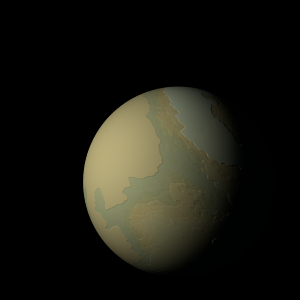|
|
Space Astro
|
Info for exoplanet "Fusobyu'beri"
| Scientific (actual) data |
|---|
| Name | YZ Cet c |
| Planet status | Confirmed |
| Mass sini | 0.00359 |
| Orbital period | 3.05989 |
| Semi major axis | 0.02156 |
| Orbit eccentricity | 0.04 |
| Discovered | 2017 |
| Updated | 2020-02-06 |
| Tperi | 2456850 |
| K | 1.68 |
| Publication | Published in a refereed paper |
| Detection type | Radial Velocity |
| Mass measurement type | Spectrum |
| Star name | YZ Cet |
| Right ascension | 18.13° |
| Declination | -17° |
| Mag v | 12.074 |
| Mag k | 6.42 |
| Star distance | 3.6 |
| Star metallicity | -0.26 |
| Star mass | 0.13 |
| Star radius | 0.168 |
| Star sp type | M4.5 |
| Star age | 4 |
| Star temperature | 3056 |
| Wikipedia article | YZ Cet c |
Back
| |
| Fictional info (?) |
|---|
| Suggested name | Fusobyu'beri |
| Planet type | Hot planet |
| It is a hot planet planet with a mass one-thousandth that of YZ Cet, but two-and-a-half times that of all the other planets in its solar system combined.
troublesome voyage.
Surface said to have barbaric and interesting insects known to feed in deep valleys by killing another species called Jojohyu Pya. They are somewhat similar to the Nokyuda Juhyu but have wings and vary in length from 60 to 90 cm. They can endure temperatures from -90 to -60°C and to some degree the high radiation level which is rare on this planet. |
| Estimated population | 1500000 |
| Atmosphere | Water | 97% |
| Oxygen | 2.3% |
| Methane | 0.1% |
| Carbon dioxide | 0.00037% |
| Atmospheric pressure | 0.3 bar |
 |
| No known satellites |
| Google search for Fusobyu'beri |
|
Website by Joachim Michaelis
|
|
|
|